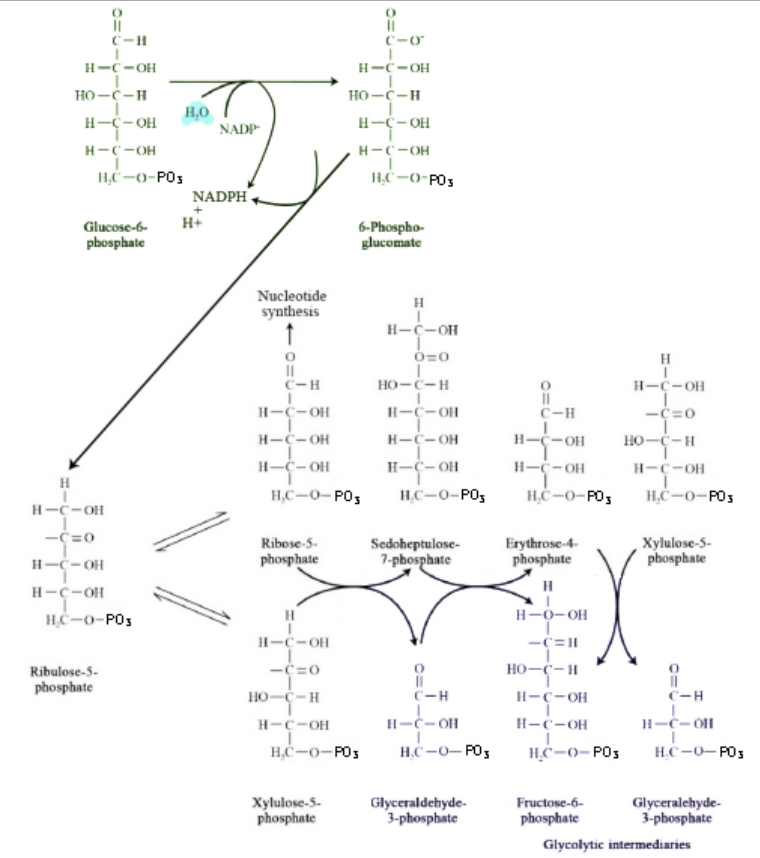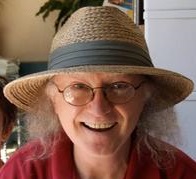7.2: Pentose Phospate Pathway
- Page ID
- 3047
The Pentose Phosphate Pathway (PPP) is one that many students are confused by. Perhaps the reason for this is that it does not really have a single direction in which it proceeds, as will be apparent below.

Portions of the PPP are similar to the Calvin Cycle of plants, also known as the dark reactions of photosynthesis. We discuss these reactions separately in the next section. The primary functions of the PPP are to produce NADPH (for use in anabolic reductions), ribose-5-phosphate (for making nucleotides), and erythrose-4-phosphate (for making aromatic amino acids). Three molecular intermediates of glycolysis can funnel into PPP (or be used as usual in glycolysis). They include G6P, fructose-6-phosphate (in two places), and glyceraldehyde-3-phosphate (also in two places).
A starting point for the pathway (though there are other entry points) is the oxidative phase. It includes two reactions generating NADPH. In the first of these, oxidation of glucose-6-phosphate (catalyzed by glucose-6-phosphate dehydrogenase), produces NADPH and 6-phosphogluconolactone. 6-phosphogluconolactone spontaneously gains water and loses a proton to become 6-phosphogluconate. Oxidation of this produces ribulose-5-phosphate and another NADPH and releases \(\text{CO}_2\). The remaining steps of the pathway are known as the non-oxidative phase and involve interconversion of sugar phosphates.
For example, ribulose-5-phosphate is converted to ribose-5-phosphate (R5P) by the enzyme ribulose-5-phosphate isomerase. Alternatively, ribulose-5-phosphate can be converted to xylulose-5-phosphate (Xu5P). R5P and Xu5P (10 carbons total) can be combined and rearranged by transketolase to produce intermediates with 3 and 7 carbons (glyceraldehyde-3-phosphate and sedoheptulose-7-phosphate, respectively). These last two molecules can, in turn be rearranged by transaldolase into 6 and 4 carbon sugars (fructose-6-phosphate and erythrose-4-phosphate, respectively). Further, the erythrose-4-phosphate can swap parts with Xu5P to create glyceraldehyde-3-phosphate and fructose-6-phosphate.
It is important to recognize that the PPP pathway is not a “top-down" pathway, with all the intermediates derived from a starting G6P. All of the reactions are reversible, so that, for example, fructose-6-phosphate and glyceraldehyde-3-phosphate from glycolysis can reverse the last reaction of the previous paragraph to provide a means of synthesizing ribose-5-phosphate non-oxidatively. The pathway also provides a mechanism to cells for metabolizing sugars, such as Xu5P and ribulose-5-phosphate. In the bottom line of the pathway, the direction the pathway goes and the intermediates it produces are determined by the needs of, and intermediates available to, the cell.
As noted above, the pathway connects in three places with glycolysis. In non- plant cells, the PPP pathway occurs in the cytoplasm (along with glycolysis), so considerable “intermingling" of intermediates can and does occur. Erythrose-4-phosphate is an important precursor of aromatic amino acids and ribose-5-phosphate is an essential precursor for making nucleotides.


